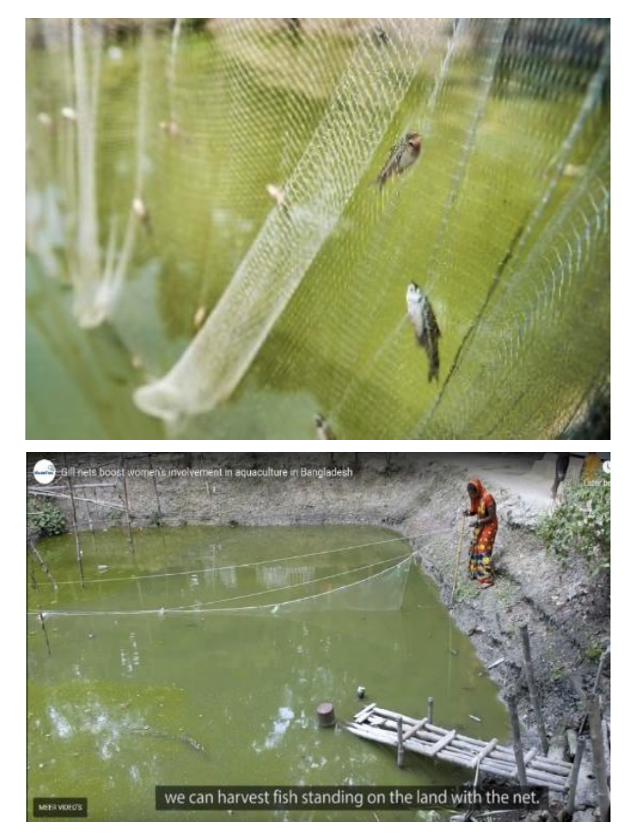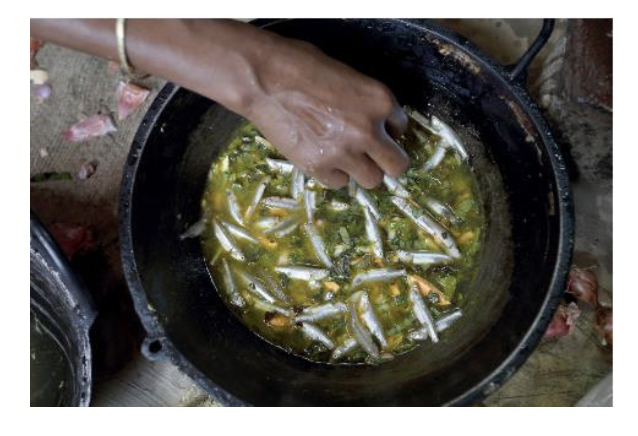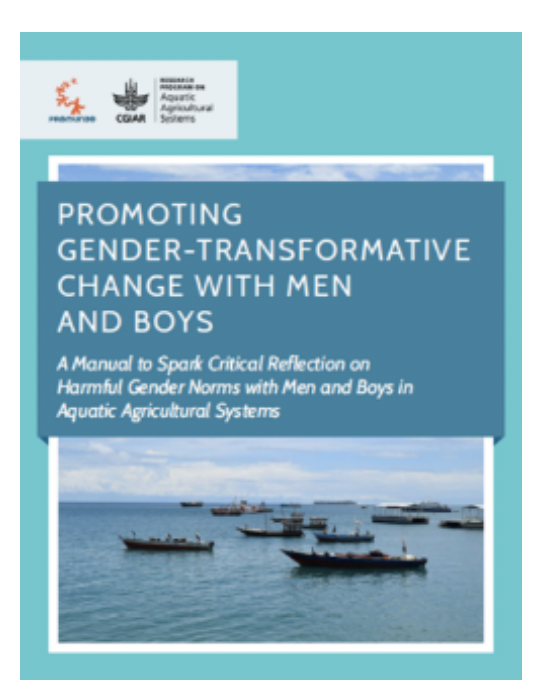農業:
將社會性別常模嵌入創新過程中
議題
農業創新往往會對女性和男性產生不同的影響。大多數的創新集中在解決技術問題上,例如提高產量、抵禦環境壓力以及管理貧瘠的土壤或種子。此類創新通常無法解釋:1) 社會性別常模如何影響技術解決方案的實施;或 2) 技術解決方案的實施將如何影響社會性別常模。因此,創新可能無法惠及女性,甚至可能擴大性別不平等(Rola-Rubzen et al., 2020; Quisumbing et al., 2014, Lawless et al., 2017, Bock & van der Burg, 2017)。
方法:分析社會性別
CGIAR國際農業研究中心聯盟的性別專家開創了 GENNOVATE計畫,旨在開發將社會性別常模嵌入創新過程的社會性別轉型(gender-transformative)取徑。其中包括:
- 促進對社會性別角色、常模和關係的批判性審查;
- 認知並加強支持平等的正向常模;
- 提高婦女、女孩和邊緣群體的地位;
- 改變造成性別不平等長期存在之基本社會結構、政策和廣為接受的信念
(Petesch et al., 2017, 2018, 2018a, 2018b; Badstue et al. 2018; Danielsen et al., 2018, with reference to IGWG 1997; see also Hillenbrand et al., 2015; Aregu et al., 2019; van der Burg, 2019; Fischer et al., 2019)
性別化創新:
- 孟加拉的刺網。與社會性別相關的文化和宗教期望禁止孟加拉農村的婦女捕魚,甚至連自家池塘的魚都不能捕捉。這類工作被視為是男性的責任。女性也不願意進入池塘,因為會弄濕她們的紗麗。為了支持性別平等並確保糧食無虞,CGIAR 的計畫之一 WorldFish 在孟加拉最貧困的地區引入了刺網。這種婦女可以自行製作的網被用於捕捉營養豐富的莫拉鯉魚。該企劃成功的關鍵在於處理性別意識的舉措,以此確保丈夫、姻親和鄰居能支持女性以刺網養殖和捕魚這個新角色。
- 在創新過程中嵌入社會性別常模。CGIAR 性別專家提出應以深度研究方法,將社會性別常模納入大型農業研發企劃中。在比爾與梅琳達蓋茲基金會資助的一個為期四年的企劃中 (2014-2018) ,他們與 GENNOVATE 合作開發了全面性的方法、報告、文章、簡報與影片,作為讓研究團隊了解農業管理中的社會性別常模以及創新過程與自然資源會如何在不同的農村環境中相互影響。
議題
方法:分析社會性別
性別化創新1:孟加拉的刺網
性別化創新2:在創新過程中嵌入性別常模
方法:參與式研究和設計
方法:分析社會性別
結論
下一步
議題
農業創新往往對女性和男性會產生不同的影響。大多數的創新都集中在解決技術問題上,例如提高產量、抵禦環境壓力以及管理貧瘠的土壤或種子。此類創新通常無法說明:1) 社會性別常模如何影響技術解決方案的實施;或 2) 技術解決方案的實施將如何影響社會性別常模。因此,創新可能無法惠及女性,甚至可能會擴大性別不平等(Rola-Rubzen et al., 2020; Quisumbing et al., 2014, Lawless et al., 2017, Bock & van der Burg, 2017)。
研究顯示,社會性別和其他常規性的社會結構往往會導致創新機會效益的不平等。約束性的社會性別常模在家庭、教育、銀行事宜等機構中根深蒂固。這限制了女性的能動性、她們獲得資源和服務的機會、流動性、代表性和決策能力,尤其對弱勢群體而言更是如此(Cole et al., 2015; Badstue et al., 2018)。而且全世界皆然(Bock & Shortall, 2017)。
 目前已發展出了一些社會性別轉型(gender-transformative)的方法來處理這些議題:
目前已發展出了一些社會性別轉型(gender-transformative)的方法來處理這些議題:
- 促進對社會性別角色、常模和關係的批判性檢視;
- 認知並加強支持平等的正向常模;
- 提高婦女、女孩和邊緣群體的地位;
- 改變造成性別不平等長期存在之基本社會結構、政策和廣為接受的信念(Petesch et al., 2017, 2018, 2018a, 2018b; Badstue et al. 2018; Danielsen et al., 2018, with reference to IGWG 1997; see also Hillenbrand et al., 2015; Aregu et al., 2019; van der Burg, 2019; Fischer et al., 2019)。
性別化創新1:孟加拉的刺網
為了克服糧食貧困,WorldFish 與孟加拉的在地合作夥伴一起領導了美國國際開發總署資助的水產養殖收入與營養企劃。 WorldFish 是國際農業研究諮商組織 (CGIAR) 中的機構之一。該企畫將新技術的引入與性別轉型方法相互結合(Kruijssen et al., 2016; 亦可參見 WorldFish,〈刺網讓孟加拉女性得以捕撈營養的漁獲〉影片, 下載於2020年2月15日)。

魚類是孟加拉最重要的動物性食物。大約 60% 的人口至少每隔一天吃一次魚,最貧困之家庭中的人每日平均食用量為 44 克。 2012 年時,約有 427 萬戶家庭(佔農村家庭的 20%)擁有魚塘(Belton & Azad, 2012)。
與社會性別相關的文化和宗教期望禁止婦女至池塘中捕魚,甚至連自家池塘的魚都不能捕捉。此類工作被視為是男性的責任。而女性也不願意進入池塘中,因為她們的紗麗會被弄濕,進而需要清洗。因此,女性大多協助餵魚及清潔池塘,而男性則負責捕撈和銷售,並為家庭做出財務決策。
為了支持性別平等並確保糧食無虞,WorldFish 開始在孟加拉最貧困的地區引入 莫拉鯉魚刺網。刺網這種漁網重量夠輕,讓女性可以從池塘的岸邊投擲——而無需下水。
刺網有不同大小的網眼——網眼大小決定了捕獲的魚的類型。魚游入網中時僅能有部份穿過網眼。當魚掙扎著想掙脫時,網子就會滑到鰓蓋後面進而將牠困住。由於這種魚網僅用於捕撈營養豐富的莫拉鯉魚(Amblypharyngodon mola),因此對男性往往欲操控的大魚捕撈幾乎不造成威脅。
婦女會參加為期八天的培訓課程,學習如何製作和使用刺網(網寬7.5米,高1.8米)。婦女們會學習如何自行透過從市場上購買低成本的網和繩子,並使用空瓶子(用來作為漂浮物)和岩石或碎磚(作為沉石墜子)來製作自己的刺網。用這些網來捕撈魚,從置網到回收漁獲大約需時30分鐘。
方法:參與式研究和設計
企劃研究人員比較了五種不同網眼尺寸的網,以確定:1) 哪種網最適合捕捉小魚; 2) 哪種網最能滿足女性的需求和偏好。 他們發現網眼1.7公分的刺網是女性的首選。

當地婦女們還學習了如何管理莫拉魚的養殖,並接受了莫拉魚的相關營養教育。莫拉魚是一種富含維生素 A、鐵和鋅的小魚。若食用整條魚,包括頭部、器官和骨骼,莫拉魚是富含微量營養素的——對身體健康和兒童發育很重要。莫拉魚刺網讓當地人得以頻繁地捕獲並食用莫拉魚。僅需 17 毫克的莫拉魚就可以為 5 歲以下的兒童供足維生素 A的建議攝取量(Kataki & Babu, 2002)。
方法:分析社會性別
該計畫成功的關鍵在於認知並改變社會性別常模。由於捕魚歷來是男性的工作,因而採取了改變性別意識的方式,以確保丈夫、姻親和鄰居能夠支持婦女擔任使用刺網養殖和捕魚的這個新角色。這處理了包括從家庭內部權力階層到食物分配等社會性別動態。他們亦處理到限制了個人和家庭福祉的社會性別常模,同時加強以合作形式來轉變性別關係的方法。女性還接受了自信心、談判技巧和果敢方面的培訓。結果顯示,男性與女性間的態度發生了變化,家庭成員之間的合作變得較緊密,對於女性吸收科技的接受度也提升了(Kruijssen et al., 2016; IFPRI Gender Breakfast, 2017; personal information from A. Choudhury)。 WorldFish 亦藉由對婦女、她們的伴侶和其他家庭成員進行調查和訪談,來觀測生產、態度和施行(技術性和社交性)的變化(Kruijssen et al., 2016)。
性別化創新2:在創新過程中嵌入社會性別常模

透過 GENNOVATE計畫,來自CGIAR國際農業研究中心聯盟,包括 WorldFish在內的性別專家合作將社會歷程,尤其是社會性別常模,整合到大規模農業研發計畫中。在這個為期四年由比爾與梅琳達蓋茲基金會贊助的研究計畫 (2014-2018) 中,他們為研究團隊開發了全面性的方法、報告、文章、簡報和影片。GENNOVATE 發展了深度研究方法,藉此了解農業和自然資源管理中的社會性別常模和創新過程如何在不同的農村環境中相互影響。
其核心研究主要處理以下問題(Petesch et al., 2017):
- 社會性別常模如何促進或阻礙在不同背景和社會結構中採用農業和自然資源管理創新技術?
- 新的農業技術或實踐會如何以及在何處促進或削弱婦女的能動性並改變社會性別常模進而對婦女帶來益處或害處?
- 社會性別常模和女性與男性能動性之變化何時以及在何種情況下會促進創新並促進具包容性的成果? 哪些背景因素會影響這種關係?
GENNOVATE 舉例說明了納入社會性別常模在內的標準化研究方法和工具。其結論是基於針對來自 26 個國家的 137 個農村社區的 7,000 多名男性和女性的小組討論和訪談(按性別、年齡和社會經濟地位劃分——參見Badstue et al., 2018; Petesch et al., 2018)
GENNOVATE用於檢查社會性別常模的方法可以應用於任何具性別敏感度的指標性研究,最可以用於作為大規模農業研發計畫的一部分的事前性別影響評估(GIA)。

這本操作手冊由 Promundo 和 CGIAR-WorldFish 開發,裡頭包括了 13 個以活動為主的小組課程,旨在讓男人和男孩參與為水產農業系統開發的性別轉型對話。 課程重點:
1.了解權力和性別不平等如何使貧困長期存在並損害福祉;
2.採取行動為婦女在水產農業發展中創造更具包容性的環境;
3.促進財務和家庭決策的共享;
4.提高談判和溝通技巧;促進男性參與照護工作;和
5.了解如何阻止暴力循環(Promundo-US and the CGIAR Research Program on Aquatic Agricultural Systems, 2016)。
結論
早期證據顯示,當技術創新的導入伴隨著推廣納入社會性別常模的性別轉型方法時,性別平等就會得到加強。Kruijssen et al. (2016)指出,若將焦點放在限制了婦女參與的根本原因時,企劃就能夠引發常模和傳統的轉變。
由技術和社會層面的相互作用開始的整合性系統方法可能會產生有利的結果,如孟加拉的刺網捕魚案例所示。它展示了整合不同參與者和活動(不同作物、牲畜和自然資源管理)的農業食品或農場系統方法如何最適合納入社會性別向度(Fisher et al., 2019;Feldstein, 2000; van der Burg, 2019)。 GENNOVATE 提供了研究證據和方法工具,用以處理性別常模與農業和資源管理之創新相互影響之方式。
下一步
本案例研究中介紹的良好做法可廣泛應用於農業研發。它們可以透過以下方式得到進一步的支持和擴展:
- 將社會性別和其他社會規範納入農業研發項目的新設計中,尤其是在指標性研究或事前的性別影響評估中。 GENNOVATE 研究人員已經提供了示例 (如 Farnworth et al., 2017, 2018, 2018a; Kawarazuka et al., 2018; Rietveld & Farnworth 2018, 2018a; Bergman Lodin et al., 2019; Lawless et al., 2019)。
- 歐洲農業創新研究將受益於處理社會性別和其他社會常模對土地所有權、培訓、信貸、行動力、決策權以及家庭和社區成員支持等資源的獲取和收益的影響(Bock and Shortall, 2017; EIGE, 2016)。
- 該領域的研究需要交織性的觀點來解決與其他社會維度或身份相關的女性和男性的異質性問題,例如社經地位、地理位置、家庭組成、宗教等(e.g. see Elias et al., 2018; Rietveld et al., 2020)。
政策:
1) 委託針對有助於世界各地農業、林業、漁業和自然管理方面的社會和性別平等之創新的設計和實施進行比較研究。
2) 支持例如歐洲創新夥伴計畫 (EIP) 等國際農業相關組織和平台策劃之針對社會性別和其他社會常規影響的意識提升,並提供他們如何透過創新持續性地降低不平等和實現更高平等的相關指導手冊。
3) 要求將特定脈絡之事前性別影響評估研究作為研究和決策的一部分。
參考資料
Aregu, L., A. Choudhury, S. Rajaratnam, M. van der Burg and C. McDougall (2020). Implications of agricultural innovation on gender norms: Gender approaches in aquatic agriculture in Bangladesh. In Sachs, C. (Ed.). Gender, Agriculture and Agrarian Transformations: Changing Relations in Africa, Latin America and Asia. Milton Park, Abingdon, Oxfordshire: Routledge, 162-179.
Badstue, L., Petesch, P., Feldman, S., Prain, G., Elias, M., & Kantor, P. (2018). Qualitative, Comparative and Collaborative Research at Large Scale: An Introduction to GENNOVATE. Journal of Gender, Agriculture and Food Security, 3 (1), 1-27.
Belton, B., and Azad, A. (2012). The characteristics and status of pond aquaculture in Bangladesh, Aquaculture, 358, pp. 196–204.
Bergman Lodin, J., Tegbaru, A., Bullock, R., Degrande, A., Wopong Nkengla, L. & Ibrahim Gaya, H. (2019). Gendered mobilities and immobilities: Women’s and men’s capacities for agricultural innovation in Kenya and Nigeria. Gender, Place & Culture 26 (12), pp. 1759-1783.
Bock, B., & van der Burg, M. (2017). Gender and international development. In: Bock, B. & Shortall, S. (Eds.) Gender and rural globalization. Wallingford and Cambridge, MA: CABI, 245-252.
Bock, B., & van der Burg, M. (2017). Gender and rural globalization. Wallingford and Cambridge, MA: CABI.
Burg, M. van der. (2020). ‘Change in the Making’: 1970s and 1980s building stones to Gender Integration in CGIAR Agricultural Research. In Sachs, C. (Ed.). Gender, Agriculture and Agrarian Transformations: Changing Relations in Africa, Latin America and Asia. Milton Park, Abingdon, Oxfordshire: Routledge, 35-57.
Cole, S.M., Puskur, R.,Rajaratnam, S. & F. Zulu, F. (2015). Exploring the intricate relationship between poverty, gender inequality, and rural masculinity: A case study from an aquatic agricultural system in Zambia. Culture, Society and Masculinities, 7 (2), 154-170.
Danielsen, K., F. Wong, and M. Mukhopadhyay (2019). Integrating “gender” in research for development: How you interpret the term can shape project achievements. CIMMYT gender resources for agricultural research and development professionals. CDMX, Mexico: CIMMYT.
Elias, M., N. Mudege, Lopez, D.E., Najjar, D., Kandiwa, V., Luis, J. Yila, J., Tegbaru, A., Ibrahim, G. & Bentaibi, A. (2018). Gendered aspirations and occupational trajectories among the rural youth: a cross-regional perspective. Journal of Gender, Agriculture and Food Security, 3 (1), 82-107.
European Institute for Gender Equality-EIGE (2016). Gender in Agriculture and Rural Development, Luxembourg: Publications Office of the European Union.
Farnworth, C.R., Jafry, T., Lama, K., Chatterjee, S. & Badstue, L. (2017). Challenging gender myths: Promoting inclusive wheat and maize research for development in Nepal. GENNOVATE resources for scientists and research teams. CDMX, Mexico: CIMMYT.
Farnworth, C. R., Bharati, P., Jafry, T., & Badstue, L. (2018). Strengthening women in wheat farming in India: Old challenges, new realities, new opportunities. GENNOVATE resources for scientists and research teams. CDMX, Mexico: CIMMYT.
Farnworth, C.R., Jafry, T., Rahman, S. & Badstue, L. (2018a). Leaving no one behind: Supporting women, poor people, and indigenous people in wheat-maize innovations in Bangladesh. GENNOVATE resources for scientists and research teams. CDMX, Mexico: CIMMYT.
Feldstein, H.S. (2000). Gender analysis: Making women visible and improving social analysis. In: Collinson, M. (Ed.), A history of farm systems research. Wallingford, K:CABI and Rome, Italy: FAO, 67-76.
Fischer, G., Wittich, S. & Fründt, S. (2019). Gender analysis in farming systems and action research: A training manual. Ibadan, Nigeria: IITA.
Hillenbrand, E., Karim, N., Mohanraj, P. & Wu, D. (2015). Measuring gender transformative change: A review of literature and promising practices. CARE USA. Working Paper.
IFPRI Gender Breakfast with CARE and WorldFish. (2017). Slides of webinar Measuring Gender-Transformative Change. In Agriculture: A review of the literature and promising practices, February 16, 2017, with presenters: Cole, S., McDougall, C. & Choudhury, A. (WorldFish); Hillenbrand, E. & Mohanraj, P. (CARE USA); discussant: R. Meinzen-Dick (IFPRI).
Kataki, P. & Babu, S.C. (2002). Food Systems for Improved Human Nutrition: Linking Agriculture, Nutrition, and Productivity. Journal of Crop Production, 6 (1/2) (#11/12).
Kawarazuka, N., Prain, G., Forsythe, L., Mayanja, S., Mudege, N.N., Babini, C. & V. Polar, V. (2018). Gender in Agricultural Mechanization: Key guiding questions. Lima, Peru: CIP.
Kruijssen, F., Audet-Belanger, G., Choudhury, A., Crissman, C., Dalsgaard, J. P. T., Dawson, C., Dickson, M., Genschick, S., Islam, M.M., Kaminski, A., Keus, H.J., McDougall, C. Banda, L.E., Muyaule, C. & Rajaratnam, S. (2016). Value chain transformation: Taking stock of WorldFish research on value chains and markets. Penang, Malaysia: CGIAR Research Program on Aquatic Agricultural Systems. Working Paper: AAS-2016-03.
Lawless, S., Doyle, K., Cohen, P., Eriksson, H., Schwarz, A. M., Teioli, H., Vavekaramui, A., Wickham, E., Masu, R., Panda, R & McDougall, C. (2017). Considering gender: Practical guidance for rural development initiatives in Solomon Islands. Penang, Malaysia: WorldFish. Program Brief.
Lawless, S., Cohen, P., McDougall, C., Orirana, G., Siota, F., & Doyle, K. (2019). Gender norms and relations: implications for agency in coastal livelihoods. Maritime Studies 18, 347–358.
Meinzen-Dick, R., Quisumbing, A., Behrman, J., Biermayr-Jenzano, P., Wilde, V., Noordeloos, M., Ragasa. C. & Beintema, N. (2010). Engendering agricultural research. International Food Policy Research Institute (IFPRI) Discussion paper 973.
Österblom, H., Wabnitz, C.C.C., Tladi, D. et al. (2020). Towards Ocean Equity. Washington, DC: World Resources Institute.
Petesch, P., Badstue, L., Prain, G., Elias, M., & Tegbaru, A. (2017). Entry points for enabling gender equality in agricultural and environmental innovation. GENNOVATE resources for scientists and research teams. CDMX, Mexico: CIMMYT.
Petesch, P., Badstue, L. & Prain, G. (2018). Gender norms, agency, and innovation in agriculture and natural resource management. The GENNOVATE methodology. Mexico, D. F.: CIMMYT.
Petesch, P., Badstue, L. B., Camfield, L., Feldman, S., Prain, G., & Kantor, P. (2018a). Qualitative, comparative and collaborative research at large scale: the GENNOVATE field Methodology. Journal of Gender, Agriculture and Food Security, 3 (1), 28-53.
Petesch, P., Bullock, R., Feldman, S., Badstue, L., Rietveld, A., Bauchspies, W., Kamanzi, A. Tegbaru, A. &Yila, J. (2018b). Normative dimensions of agency and agricultural decision-making in Sub-Saharan Africa. Journal of Gender, Agriculture and Food Security, 3 (1), 108-130.
Promundo-US and the CGIAR Research Program on Aquatic Agricultural Systems (2016). Promoting gender-transformative change with men and boys: A manual to spark critical reflection on harmful gender norms with men and boys in aquatic agricultural systems. Washington DC: Promundo-US and Penang: CGIAR.
Quisumbing, A., Meinzen-Dick, R., Raney, T.L., Croppenstedt, A. Behrman, J. A. & Peterman, A. (Eds.) (2014). Gender in agriculture. Closing the knowledge gap. Dordrecht: Springer.
Rietveld, A., & Farnworth, C.R. (2018). Towards gender-responsive banana research for development in the East-African Highlands. GENNOVATE resources for scientists and research teams. CDMX, Mexico: CIMMYT.
Rietveld, A., & Farnworth, C.R. (2018a). Continuity and change: Negotiating gender norms in agricultural research for development in Rwanda. GENNOVATE resources for scientists and research teams. CDMX, Mexico: CIMMYT
Rietveld, A. M., van der Burg, M., & Groot, J. C. (2020). Bridging youth and gender studies to analyse rural young women and men's livelihood pathways in Central Uganda. Journal of Rural Studies, 75, 152–163.
Rola‐Rubzen, M. F., Paris, T., Hawkins, J., & Sapkota, B. (2020). Improving Gender Participation in Agricultural Technology Adoption in Asia: From Rhetoric to Practical Action. Applied Economic Perspectives and Policy, 42 (1), 113-125.
Sachs, C.E., Jensen, L., Castellanos, P. & Sexsmith, K. (Eds.) (2021). Gender in Agriculture Handbook, Milton Park, Abingdon, Oxfordshire: Routledge.
Swim, J.K., Vescio, T. K., Dahl, J. L. & Zawadzki, S. J. (2018). Gendered discourse about climate change policies. Global Environmental Change, 48, 216-225.

農業創新往往會對女性和男性帶來不同的影響。大多數的創新都集中在解決技術問題上,例如提高產量。此類創新未能考慮:1) 社會性別常模如何影響技術解決方案的實施;或 2) 技術解決方案的實施如何影響社會性別常模。因此,這些創新可能無法觸及女性,甚至可能加劇性別不平等。
性別化創新:孟加拉的刺網。與社會性別相關的文化和宗教期望禁止孟加拉農村的婦女捕魚,甚至連自家池塘的魚都不能捕捉。為了支持性別平等並確保糧食無虞,WorldFish 在孟加拉最貧困的地區引入了刺網。這種可由婦女們自行製作的漁網用於捕撈營養豐富的莫拉鯉魚。該計畫成功的關鍵在於關注社會性別常模的舉措,以此確保丈夫、姻親和鄰居能支持婦女使用刺網養殖和捕魚。